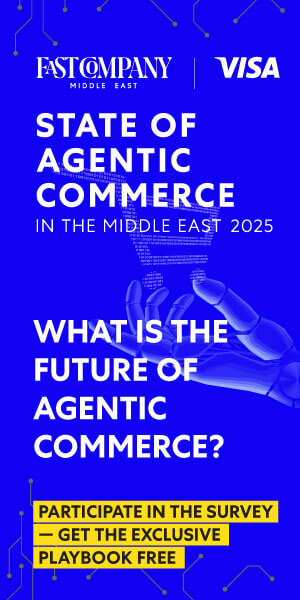- | 9:00 am
Why Middle East business leaders feel curiosity, not control, is the key to thriving in the age of AI
Experts in the region discuss key areas of leadership, keeping people and purpose relevant

AI is rewriting the rules of work, and it’s doing so at a pace faster than anyone can update a training manual or corporate guideline. Across the Gulf, business leaders are racing to keep their people, and their purpose, relevant. However, the difference between organizations that thrive and those that merely react often comes down to one thing: how they approach learning.
Ravi Chandran, a senior hospitality leader who has led brands such as The Coffee Club, which he expanded across the GCC, believes the rise of AI and automation makes one truth impossible to ignore: organizations must upskill their people in data literacy, analysis, and decision-making, or risk falling behind.
“Few companies have gone all in on AI yet,” Chandran says. “But as tools become more accessible and affordable, adoption will only accelerate—especially in customer-driven sectors like hospitality, aviation, retail, and banking, where seamless experience is everything.”
MAKING LEARNING PART OF YOUR DNA
“Many companies are rushing to reskill,” says Sid Bhatia, Area VP & General Manager – Middle East, Turkey, and Africa at Dataiku. “The problem is, most do it only after disruption hits. Upskilling has to be proactive, not reactive.”
So, what does proactive look like? It’s cultural, data-driven, and deeply human.
Jessica Constantinidis, Innovation Officer EMEA at ServiceNow, notes that even innovation officers struggle to keep pace with the rapid pace of technological change. “I made myself a promise: if I want to stay relevant, I must spend at least 30–40 minutes of my personal time every day following what’s happening in AI and technology,” she says. “Innovation and change have to be in your DNA. If you try to force-feed training, it won’t work.”
Instead of pushing employees to learn, she suggests creating FOMO, the fear of missing out. “It’s far more effective than using the stick,” she says. Her team identifies “AI champions”, employees of all ages who experiment and then teach others. This ‘teach-the-teacher’ model, she adds, “spreads curiosity like wildfire.”
But curiosity thrives only in safe spaces. Psychological safety is just as critical. “People fear they’ll get fired if they mess up while experimenting,” Constantinidis says. “Companies must make it clear that it’s okay to fail while learning.”
UPSKILLING LIKE R&D
Drawing on his 34 years across the GCC, Chandran believes that many organizations still underestimate the long-term value of learning. “You can’t build customer loyalty without first investing in your people.”
He notes that in many companies, training has become a tick-box exercise. “Many owners, investors, and CEOs are more concerned with quarterly earnings and valuations,” he adds.
Bhatia agrees that the biggest mistake is treating upskilling as merely a compliance measure. “You should treat learning the same way you treat R&D,” he says. “Allocate real budgets, involve senior management, and align learning with long-term business goals. When learning becomes part of your growth strategy, you stop reacting to change—you start shaping it.”
“Tracking trends and emerging technologies helps you anticipate needs early. Too many firms wait until the shortage hurts—then it’s painful and expensive to fix,” he adds.
Bhatia says that a data-driven framework also ensures safer experimentation. “Many people use random AI tools without guidance. Smart enterprises are creating internal AI schools and frameworks that allow for innovation while setting boundaries.”
REDEFINING WHAT SUCCESS LOOKS LIKE
In the world of AI, traditional KPIs often fail to tell the full story. Constantinidis recalls working with a company that successfully automated a process, resulting in a monthly savings of 2,000 person-hours. “I asked them: ‘What will you do with those hours?’ They had no answer,” she says. “If you’re not reinvesting that time into innovation or growth, you’ve just created redundancy.”
Bhatia suggests that every organization should track three key metrics. The first is the field activation index, which must consider whether employees are applying new skills to real projects. The second is time-to-productivity. “This refers to how quickly reskilled employees deliver results,” he says. Lastly, consider collaboration metrics. “When cross-functional teams start collaborating more after training, that’s a real sign of success. Innovation in AI is a team sport.”
Leaders must also shift their mindset from profit to purpose. “Too many employers focus on maximizing profit with minimal investment, forgetting that it’s their people who make or break the business,” Chandran says. “Lead with purpose, not profit. Train and empower your people, and you’ll build loyalty, both internally and with your customers.”
HIRE FOR CURIOSITY, NOT CREDENTIALS
As AI reshapes job roles, leaders agree that the next generation of talent won’t be defined by degrees. “I always hire the underdog,” Constantinidis admits. “If someone comes in with five degrees and a flawless résumé, I sometimes hesitate. Curiosity and grit beat credentials every time.”
She also values “unofficial” experiences, such as leading a football team or volunteering, because they demonstrate initiative and collaboration that “no MBA can teach.”
In a region as diverse as the Middle East, emotional intelligence is as important as technical ability, Bhatia says. “Leaders must understand the human side of transformation. Communication, trust, and empathy hold multicultural teams together.”
Both foresee a new renaissance of generalists—people who connect dots across disciplines while using AI as an amplifier.
EMPOWER, DON’T INSTRUCT
Every issue in an organization ultimately traces back to leadership. “It cascades down—from how a leader hires, trains, empowers, and recognizes their people,” Chandran says. Employees can learn any skill and adapt to any change. The real gap is leadership courage—the willingness to empower people to experiment.”
He adds that educators constantly update their teaching methods, but companies often fail to empower employees to apply what they’ve learned. “Leaders play it safe with tried-and-tested methods,” he says. “They lose their best talent to those willing to take risks.”
Bhatia agrees that leadership today is no longer about control, but about enabling continuous learning. “Don’t just instruct—empower,” he says. “Create space for experimentation.”
Constantinidis adds that leaders must model curiosity themselves. “If your people see you experimenting with AI tools, they’ll feel safe doing it too,” she says. “Curiosity is contagious.”





































